From The NSF NOIRLab NOAO Gemini Observatory
And
The Subaru Telescope [すばる望遠鏡]| NAOJ: National Astronomical Observatory of Japan [国立天文台] (JP)
6.17.24
Yoshiki Matsuoka
Research Center for Space and Cosmic Evolution, Ehime University, Japan
Email: yk.matsuoka@cosmos.phys.sci.ehime-u.ac.jp
Josie Fenske
Jr. Public Information Officer
NSF NOIRLab
Email: josie.fenske@noirlab.edu
Miki Ishii
National Astronomical Observatory of Japan
Subaru Telescope Senior Specialist
Email: ishii.miki@nao.ac.jp
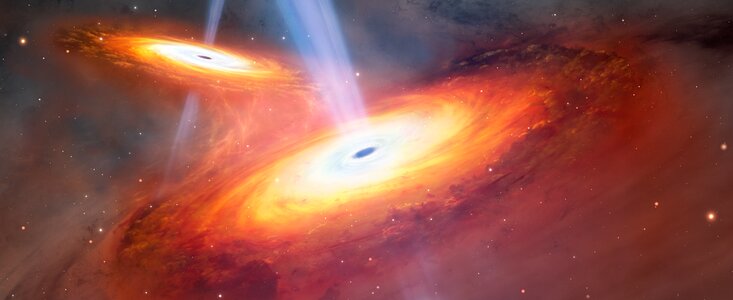
This illustration depicts two quasars in the process of merging. Using both the Gemini North telescope, one half of the International Gemini Observatory, which is supported in part by the U.S. National Science Foundation and operated by NSF NOIRLab, and the Subaru Telescope, a team of astronomers have discovered a pair of merging quasars seen only 900 million years after the Big Bang. Not only is this the most distant pair of merging quasars ever found, but also the first confirmed pair found in the period of the Universe known as Cosmic Dawn. Credit: International Gemini Observatory/NOIRLab/NSF/AURA/M. Garlick

Since the very first instant after the Big Bang the Universe has been expanding.
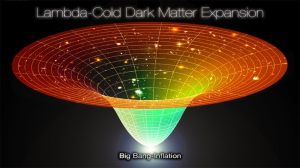
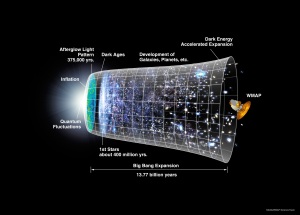

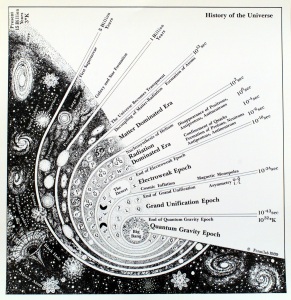
This means that the early Universe was considerably smaller and early-formed galaxies were more likely to interact and merge. Galaxy mergers fuel the formation of quasars — extremely luminous galactic cores where gas and dust falling into a central supermassive black hole emit enormous amounts of light. So when looking back at the early Universe astronomers would expect to find numerous pairs of quasars in close proximity to each other as their host galaxies undergo mergers. However, they have been surprised to find exactly none — until now.
With the aid of the Gemini North telescope [below], one half of the International Gemini Observatory, which is supported in part by the U.S. National Science Foundation and operated by NSF NOIRLab, a team of astronomers have discovered a pair of merging quasars seen only 900 million years after the Big Bang. Not only is this the most distant pair of merging quasars ever found, but also the first confirmed pair in the period of the Universe’s history known as Cosmic Dawn.
Cosmic Dawn spanned from about 50 million years to one billion years after the Big Bang. During this period the first stars and galaxies began appearing, filling the dark Universe with light for the first time. The arrival of the first stars and galaxies kicked off a new era in the formation of the cosmos known as the Epoch of Reionization.

The Epoch of Reionization, which took place within Cosmic Dawn, was a period of cosmological transition. Beginning roughly 400 million years after the Big Bang, ultraviolet light from the first stars, galaxies and quasars spread throughout the cosmos, interacting with the intergalactic medium and stripping the Universe’s primordial hydrogen atoms of their electrons in a process known as ionization. The Epoch of Reionization was a critical epoch in the history of the Universe that marked the end of the cosmic dark ages and seeded the large structures we observe in our local Universe today.

To understand the exact role that quasars played during the Epoch of Reionization, astronomers are interested in finding and studying quasars populating this early and distant era. “The statistical properties of quasars in the Epoch of Reionization tell us many things, such as the progress and origin of the reionization, the formation of supermassive black holes during Cosmic Dawn, and the earliest evolution of the quasar host galaxies,” said Yoshiki Matsuoka, an astronomer at Ehime University in Japan and lead author of the paper describing these results, published in The Astrophysical Journal Letters.
About 300 quasars have been discovered in the Epoch of Reionization, but none of them have been found in a pair. That is until Matsuoka and their team were reviewing images taken with the Hyper Suprime-Cam [below] on the Subaru Telescope [below] and a faint patch of red caught their eye. “While screening images of quasar candidates I noticed two similarly and extremely red sources next to each other,” said Matsuoka. “The discovery was purely serendipitous.”
The team was not sure that they were a quasar pair since distant quasar candidates are contaminated by numerous other sources, such as foreground stars and galaxies and the effects of gravitational lensing.


To confirm the nature of these objects the team conducted follow-up spectroscopy using the Faint Object Camera and Spectrograph (FOCAS) [below] on the Subaru Telescope and the Gemini Near-Infrared Spectrograph (GNIRS) [below] on Gemini North. The spectra, which break down the emitted light from a source into its component wavelengths, obtained with GNIRS were crucial to characterizing the nature of the quasar pair and their host galaxies.
“What we learned from the GNIRS observations was that the quasars are too faint to detect in near-infrared, even with one of the largest telescopes on the ground,” said Matsuoka. This allowed the team to estimate that a portion of the light detected in the optical wavelength range is not coming from the quasars themselves, but from ongoing star formation taking place in their host galaxies. The team also found that the two black holes are whoppers, each being 100 million times the mass of the Sun. This, coupled with the presence of a bridge of gas stretching between the two quasars, suggests that they and their host galaxies are undergoing a major-scale merger [1].
“The existence of merging quasars in the Epoch of Reionization has been anticipated for a long time. It has now been confirmed for the first time,” said Matsuoka [2].
The Epoch of Reionization connects the earliest formation of cosmic structure to the complex Universe that we observe billions of years later. By studying distant objects from this period astronomers gain valuable insight into the process of reionization and the formation of the first objects in the Universe. More discoveries like this may be on the horizon with NSF–DOE Vera C. Rubin Observatory’s decade-long Legacy Survey of Space and Time (LSST), beginning in 2025, which is poised to detect millions of quasars using its deep imaging capabilities.

Notes
[1] A companion paper accepted for publication in AAS Journals presents further analysis of the quasar pair, the gas bridge between them and their host galaxies using observations taken with the Atacama Large Millimeter/submillimeter Array (ALMA).

[2] There have been candidates, but it is difficult to separate them from possibly gravitationally-lensed images of a single quasar. There are also some candidates for being dual active galactic nuclei embedded in individual Epoch of Reionization galaxies, but these have much lower luminosity (black hole activity) than quasars and are two components within a single galaxy, which are qualitatively different from what is described here.
More information
The team is composed of Yoshiki Matsuoka (Ehime University, Japan), Takuma Izumi (National Astronomical Observatory of Japan, Tokyo), Masafusa Onoue (Kavli Institute for the Physics and Mathematics of the Universe, Japan), Michael A. Strauss (Princeton University, USA), Kazushi Iwasawa (Universitat de Barcelona Spain), Nobunari Kashikawa (University of Tokyo, Japan), Masayuki Akiyama (Tohoku University, Japan), Kentaro Aoki (Subaru Telescope, National Astronomical Observatory of Japan, USA), Junya Arita (University of Tokyo, Japan), Masatoshi Imanishi (National Astronomical Observatory of Japan, Graduate University for Advanced Studies [SOKENDAI], Japan), Rikako Ishimoto (University of Tokyo, Japan), Toshihiro Kawaguchi (Onomichi City University, Japan), Kotaro Kohno (University of Tokyo, Japan), Chien-Hsiu Lee (W. M. Keck Observatory, USA), Tohru Nagao (Ehime University, Japan), John D. Silverman (Kavli Institute for the Physics and Mathematics of the Universe, Japan), and Yoshiki Toba (Ehime University, Japan, National Astronomical Observatory of Japan, Tokyo, Academia Sinica Institute of Astronomy and Astrophysics, Taiwan)
See the full article here .
Comments are invited and will be appreciated, especially if the reader finds any errors which I can correct.

five-ways-keep-your-child-safe-school-shootings
Please help promote STEM in your local schools.
The Subaru Telescope [すばる望遠鏡]| NAOJ: National Astronomical Observatory of Japan [国立天文台] (JP)


Subaru Telescope (すばる望遠鏡, Subaru Bōenkyō) is the 8.2-meter (320 in) flagship telescope of the National Astronomical Observatory of Japan, located at the Maunakea Observatory on Hawai’i. It is named after the open star cluster known in English as the Pleiades. It had the largest monolithic primary mirror in the world from its commissioning until 2005.
The Subaru Telescope is a Ritchey-Chretien reflecting telescope. Instruments can be mounted at a Cassegrain focus below the primary mirror; at either of two Nasmyth focal points in enclosures on the sides of the telescope mount, to which light can be directed with a tertiary mirror; or at the prime focus in lieu of a secondary mirror, an arrangement rare on large telescopes, to provide a wide field of view suited to deep wide-field surveys.
In 1984, the University of Tokyo {東京大学;Tōkyō daigaku](JP) formed an engineering working group to develop and study the concept of a 7.5-meter (300 in) telescope. In 1985, the astronomy committee of Japan’s science council gave top priority to the development of a “Japan National Large Telescope” (JNLT), and in 1986, the University of Tokyo signed an agreement with the University of Hawaii to build the telescope in Hawaii. In 1988, the National Astronomical Observatory of Japan was formed through a reorganization of the University’s Tokyo Astronomical Observatory, to oversee the JNLT and other large national astronomy projects.
Construction of the Subaru telescope began in April 1991, and later that year, a public contest gave the telescope its official name, “Subaru Telescope.” Construction was completed in 1998, and the first scientific images were taken in January 1999. In September 1999, Princess Sayako of Japan dedicated the telescope.
A number of state-of-the-art technologies were worked into the telescope design. For example, 261 computer-controlled actuators press the main mirror from underneath, which corrects for primary mirror distortion caused by changes in the telescope orientation. The telescope enclosure building is also shaped to improve the quality of astronomical images by minimizing the effects caused by atmospheric turbulence.
Subaru is one of the few state-of-the-art telescopes to have been used with the naked eye. For the dedication, an eyepiece was constructed so that Princess Sayako could look through it directly. It was enjoyed by the staff for a few nights until it was replaced with the much more sensitive working instruments.
Subaru is the primary tool in the search for “Planet Nine”. Its large field of view, 75 times that of the Keck telescopes, and strong light-gathering power are suited for deep wide-field sky surveys. The search, split between a research group led by Batygin and Brown and another led by Sheppard and Trujillo, is expected to take up to five years.
Instruments
Several cameras and spectrographs can be mounted at Subaru Telescope’s four focal points for observations in visible and infrared wavelengths.
Multi-Object Infrared Camera and Spectrograph (MOIRCS)

Wide-field camera and spectrograph with the ability to take spectra of multiple objects simultaneously, mounts at the Cassegrain focus.
Used in conjunction with the new 188-element adaptive optics unit (AO188), mounted at the infrared Nasmyth focus.


Mid-infrared camera and spectrometer with the ability to study cool interstellar dust, mounts on the Cassegrain focus.

Visible-light camera and spectrograph with the ability to take spectra of up to 100 objects simultaneously, mounts on the Cassegrain focus.
Subaru Prime Focus Camera (Suprime-Cam)


High Dispersion Spectrograph (HDS)
Visible-light spectrograph mounted at the optical Nasmyth focus.
Fiber Multi Object Spectrograph (FMOS)

Infrared spectrograph using movable fiber optics to take spectra of up to 400 objects simultaneously. Mounts at the prime focus.
High-Contrast Coronographic Imager for Adaptive Optics (HiCIAO)

Infrared camera for hunting planets around other stars. Used with AO188, mounted at the infrared Nasmyth focus.

This 900-megapixel ultra-wide-field (1.5° field of view) camera saw first light in 2012, and will be offered for open-use in 2014. The extremely large wide-field correction optics (a seven-element lens with some elements up to a meter in diameter) was manufactured by Canon and delivered March 29, 2011. It will be used for surveys of weak lensing to determine dark matter distribution.
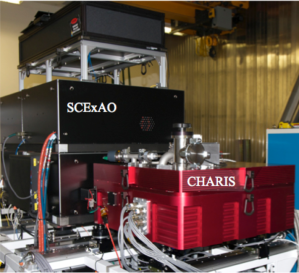
The Subaru Coronagraphic Extreme Adaptive Optics (SCExAO) instrument is a high-contrast imaging system for directly imaging exoplanets. The coronagraph uses a Phase Induced Amplitude Apodization (PIAA) design which means it will be able to image planets closer to their stars than conventional Lyot type coronagraph designs. For example, at a distance of 100 pc, the PIAA coronagraph on SCExAO would be able to image from 4 AU outwards while Gemini Planet Imager and VLT-SPHERE from 12 AU outwards. The system also has several other types of coronagraph: Vortex, Four-Quadrant Phase Mask and 8-Octant Phase Mask versions, and a shaped pupil coronagraph. The phase I of construction is complete and phase II construction to be complete by end of 2014 for science operations in 2015. SCExAO will initially use the HiCIAO camera but this was replaced by CHARIS around 2016.













Gemini’s mission is to advance our knowledge of the Universe by providing the international Gemini Community with forefront access to the entire sky.
The NSF NOIRLab Gemini Observatory is an international collaboration with two identical 8-meter telescopes. The Frederick C. Gillett Gemini Telescope is located on Maunakea, Hawai’i (Gemini North) and the other telescope on Cerro Pachón in central Chile (Gemini South); together the twin telescopes provide full coverage over both hemispheres of the sky. The telescopes incorporate technologies that allow large, relatively thin mirrors, under active control, to collect and focus both visible and infrared radiation from space.
The Gemini Observatory provides the astronomical communities in six partner countries with state-of-the-art astronomical facilities that allocate observing time in proportion to each country’s contribution. In addition to financial support, each country also contributes significant scientific and technical resources. The national research agencies that form the Gemini partnership include: the US National Science Foundation (NSF), the Canadian National Research Council (NRC), the Chilean Comisión Nacional de Investigación Cientifica y Tecnológica (CONICYT), the Australian Research Council (ARC), the Argentinean Ministerio de Ciencia, Tecnología e Innovación Productiva, and the Brazilian Ministério da Ciência, Tecnologia e Inovação. The observatory is managed by the Association of Universities for Research in Astronomy, Inc. (AURA) under a cooperative agreement with the NSF. The NSF also serves as the executive agency for the international partnership.
National Science Foundation’s NOIRLab (National Optical-Infrared Astronomy Research Laboratory ), the US center for ground-based optical-infrared astronomy, operates the international Gemini Observatory (a facility of NSF, National Research Council Canada (CA), Agancia Nacional de IInvestigacion y Desarrollo (CL), Ministry of Science, Technology and Innovation [Ministério da Ciência, Tecnologia e Inovações] (BR), Ministry of Science, Technology and Innovation | Argentina.gob.Ministerio de Ciencia, Tecnología e Innovación | Argentina.gob.(AR), and Korea Astronomy and Space Science Institute[알림사항](KR), Kitt Peak National Observatory (KPNO) , NSF NOAO Cerro Tololo Inter-American Observatory (CL), the NOAO Community Science and Data Center (CSDC), and Vera C. Rubin Observatory in cooperation with DOE’s SLAC National Accelerator Laboratory .).
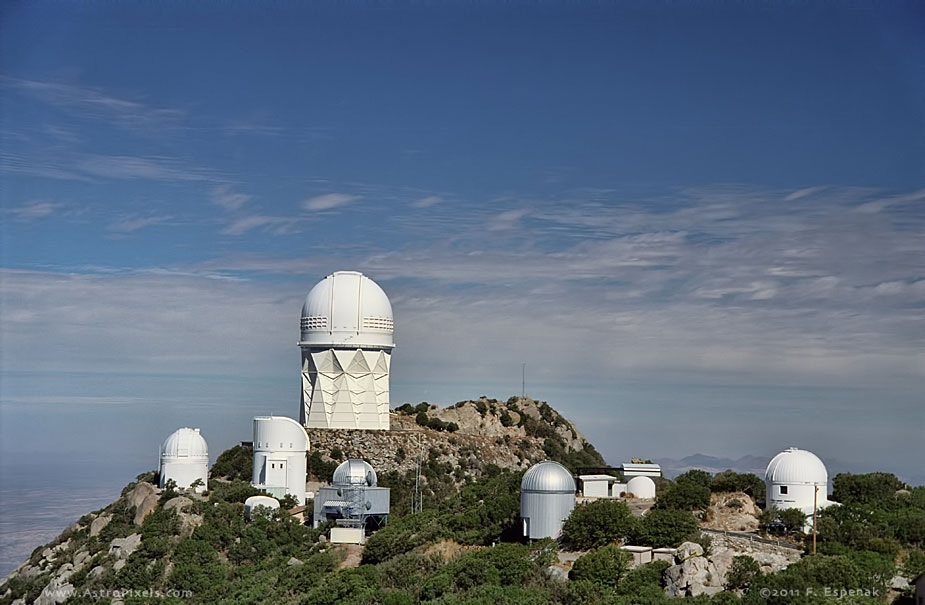

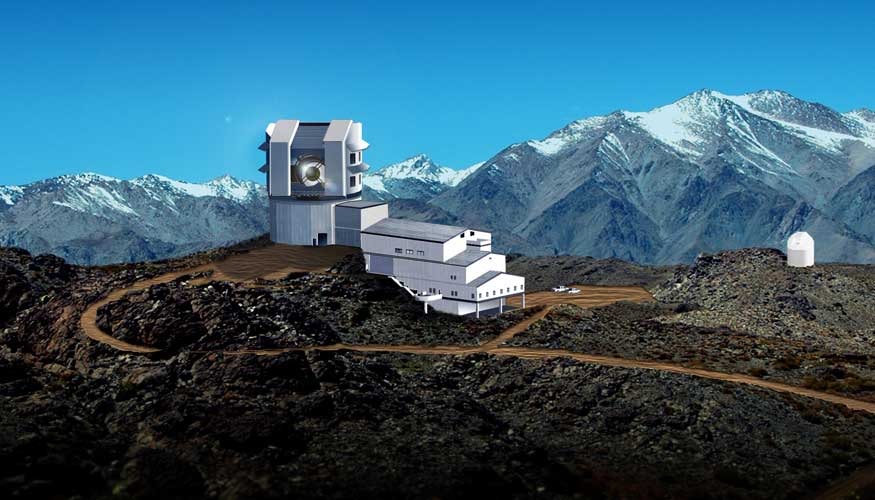
It is managed by the Association of Universities for Research in Astronomy (AURA) under a cooperative agreement with National Science Foundation and is headquartered in Tucson, Arizona.
The Dark Energy Survey
Dark Energy Camera [DECam] built at the DOE’s Fermi National Accelerator Laboratory.

The astronomical community is honored to have the opportunity to conduct astronomical research on Iolkam Du’ag (Kitt Peak) in Arizona, on Maunakea in Hawaiʻi, and on Cerro Tololo and Cerro Pachón in Chile. We recognize and acknowledge the very significant cultural role and reverence that these sites have to the Tohono O’odham Nation, to the Native Hawai’ian community, and to the local communities in Chile, respectively.






